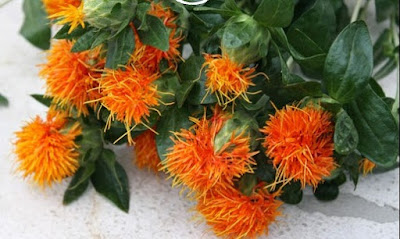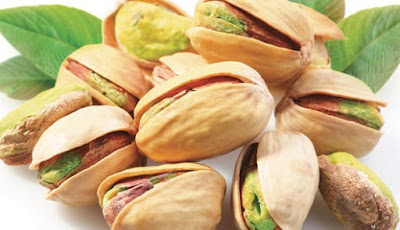Safflower (kusum, kusumbha, kardi) is one of the
oldest cultivated annual oilseed crops
which are well adapted to dry regions. The safflower seed also used to produce
oil. Safflower is a thistle-like plant with a central branch stem, a varying
number of branches and a tap-root system. Each branch has 1 to 5 yellow or
orange flowers and contains 15 to 20 seeds. This crop seed contains about 30 to
40 % oil. In India, This safflower oil (golden yellow coloured) is largely used
for cooking purposes. The main benefit of this seed is to produce cake after
oil extraction which is being used as cattle feed. The green safflower crop can
also be used as a green fodder for cattle and the livestock. When it comes to
nativity of safflower, it is believed that safflower is native to Arabia
region. However, this crop is grown most of the other parts of the world as
well. India ranks first in the world
with respect to acreage accounting for about 35 % of the world total production
of safflower. Maharashtra and Karnataka states are major producers this crop in
India. Safflower belongs to the family of "Asteraceae" and genus of
"Carthamus". The botanical name or scientific name of safflower is
"Carthamus tinctorius L." Read more here.
Monday 28 March 2016
Friday 18 March 2016
Vanilla Cultivation Guide
Vanilla is a tropical climbing vine of the orchid
family, grown for its pleasant flavour. Vanilla is one of the costliest spices
in the market after saffron and grows with the support of bark of trees. There
are than 40 species of vanilla exist. However, only three of them are
considered as important ones. Vanilla
planifolia Andrews is the variety widely cultivated on large scale. This
cultivar (variety) has more commercial value for its vanillin. Vanilla vine is
a perennial in nature which belongs to the family of "Orchidaceae"
and genus of "Vanilla". Madagascar is the top producer of vanilla in
the world. Usually, Vanilla plants start the first yield after 3 years of
planting and continue to give the yield up to 12 to 14 years. Generally,
vanilla crop is grown as an intercrop in the fields of ‘coconut’ and ‘areca
nut’. As India is concerned, Indian exports of vanilla multiplied rapidly and
accounted for approximately 2% of world vanilla exports. In India, Karnataka tops
the country's vanilla cultivation followed by Kerala and Tamil Nadu states. The
vanilla vines can be grown in indoors, greenhouse even in pots and containers.
The initial investment for the cultivation of vanilla is little when compared
to other spices. Vanilla also can be grown hydroponically. Continue Reading Here.
Friday 11 March 2016
Jatropha Farming Guide
Jatropha curcas is one of the best oil seed plants and identified as most suitable oil seed bearing plant due to its various favourable attributes. Jatropha is a deciduous large shrub or small tree that can reach up to 5 meters in height with smooth gray bark. Jatropha plants are native to Central America and well-adapted to the tropics and subtropics of the world. Jatropha is a hard plant and it has short gestation period when compared to other oil seed crops. The other advantage of the plant is it has wider adaptability of different climatic conditions and can be grown in most of the areas. The other reason to go for the cultivation of Jatropha is; it produces high quality oil and oil recovery is very high. Cultivation of Jatropha appears viable due to its demand. Basically, Jatropha crop meant for wastelands and less productive lands, hence this crop will not replace other important food crops grown in rich soils. Jatropha plants produce oil seeds as a source of energy in the form of biodiesel. Jatropha plants belong to the family of “Euphorbiaceae” and genus of “Jatropha L.”. For More Information click here.
Wednesday 2 March 2016
Pistachio Growing Guide
Pistachios are grown for its edible nuts and
pistachio tree is a small to medium sized tree with a branching main stem and a
spreading growth habit. It can reach up to 20 feet height in wild conditions
and up to 10 feet in cultivated conditions. Pistachio is one of the culinary nuts
grown in most of the countries and belongs to the cashew family. These nuts are
the lowest calorie of the nuts, but they are rich in phytosterols,
antioxidants, unsaturated fat, carotenoids, vitamins and minerals and fiber. It
is uncertain where pistachio nut trees originated but probably originated from
Middle East and Central Asia. Pistachios
belong to the family of “Anacardiaceae and genus of "Pistacia". Basically pistachio trees are either male or female. However,
both are required to produce a crop. Usually the nuts are produced on the
female trees where as male trees provide the pollen to fertilize the female
tree flowers. Pistachio trees take longer time to get into production stage.
Pistachio nuts have excellent
demand both locally and internationally. One can obtain decent profits if they
are grown in right climate by following good farming practices. Continue reading here.
Subscribe to:
Posts (Atom)



